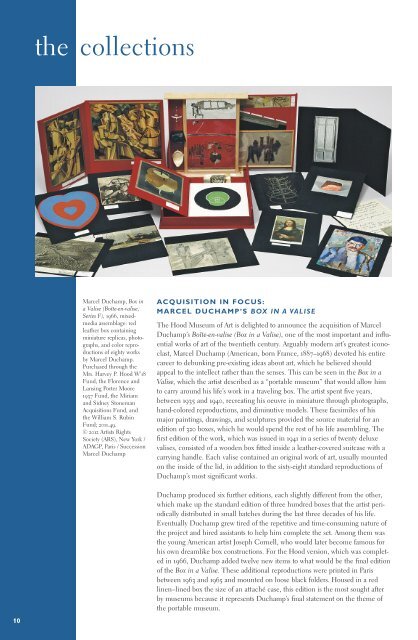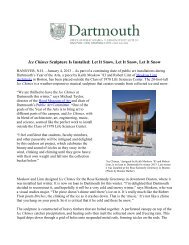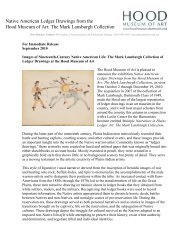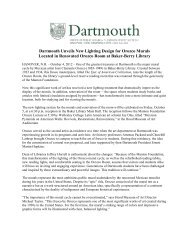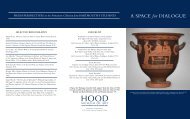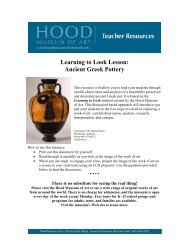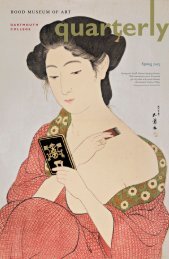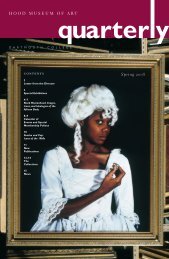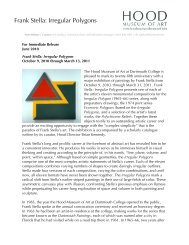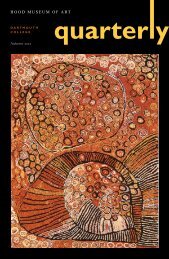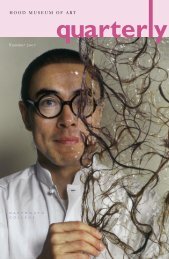Spring 2012 - Hood Museum of Art - Dartmouth College
Spring 2012 - Hood Museum of Art - Dartmouth College
Spring 2012 - Hood Museum of Art - Dartmouth College
Create successful ePaper yourself
Turn your PDF publications into a flip-book with our unique Google optimized e-Paper software.
the collections<br />
Marcel Duchamp, Box in<br />
a Valise (Boîte-en-valise,<br />
Series F), 1966, mixedmedia<br />
assemblage: red<br />
leather box containing<br />
miniature replicas, photographs,<br />
and color reproductions<br />
<strong>of</strong> eighty works<br />
by Marcel Duchamp.<br />
Purchased through the<br />
Mrs. Harvey P. <strong>Hood</strong> W’18<br />
Fund, the Florence and<br />
Lansing Porter Moore<br />
1937 Fund, the Miriam<br />
and Sidney Stoneman<br />
Acquisitions Fund, and<br />
the William S. Rubin<br />
Fund; 2011.49.<br />
© <strong>2012</strong> <strong>Art</strong>ists Rights<br />
Society (ARS), New York /<br />
ADAGP, Paris / Succession<br />
Marcel Duchamp<br />
ACQUISITION IN FOCUS:<br />
MARCEL DUCHAMP’S BOX IN A VALISE<br />
The <strong>Hood</strong> <strong>Museum</strong> <strong>of</strong> <strong>Art</strong> is delighted to announce the acquisition <strong>of</strong> Marcel<br />
Duchamp’s Boîte-en-valise (Box in a Valise), one <strong>of</strong> the most important and influential<br />
works <strong>of</strong> art <strong>of</strong> the twentieth century. Arguably modern art’s greatest iconoclast,<br />
Marcel Duchamp (American, born France, 1887–1968) devoted his entire<br />
career to debunking pre-existing ideas about art, which he believed should<br />
appeal to the intellect rather than the senses. This can be seen in the Box in a<br />
Valise, which the artist described as a “portable museum” that would allow him<br />
to carry around his life’s work in a traveling box. The artist spent five years,<br />
between 1935 and 1940, recreating his oeuvre in miniature through photographs,<br />
hand-colored reproductions, and diminutive models. These facsimiles <strong>of</strong> his<br />
major paintings, drawings, and sculptures provided the source material for an<br />
edition <strong>of</strong> 320 boxes, which he would spend the rest <strong>of</strong> his life assembling. The<br />
first edition <strong>of</strong> the work, which was issued in 1941 in a series <strong>of</strong> twenty deluxe<br />
valises, consisted <strong>of</strong> a wooden box fitted inside a leather-covered suitcase with a<br />
carrying handle. Each valise contained an original work <strong>of</strong> art, usually mounted<br />
on the inside <strong>of</strong> the lid, in addition to the sixty-eight standard reproductions <strong>of</strong><br />
Duchamp’s most significant works.<br />
Duchamp produced six further editions, each slightly different from the other,<br />
which make up the standard edition <strong>of</strong> three hundred boxes that the artist periodically<br />
distributed in small batches during the last three decades <strong>of</strong> his life.<br />
Eventually Duchamp grew tired <strong>of</strong> the repetitive and time-consuming nature <strong>of</strong><br />
the project and hired assistants to help him complete the set. Among them was<br />
the young American artist Joseph Cornell, who would later become famous for<br />
his own dreamlike box constructions. For the <strong>Hood</strong> version, which was completed<br />
in 1966, Duchamp added twelve new items to what would be the final edition<br />
<strong>of</strong> the Box in a Valise. These additional reproductions were printed in Paris<br />
between 1963 and 1965 and mounted on loose black folders. Housed in a red<br />
linen–lined box the size <strong>of</strong> an attaché case, this edition is the most sought after<br />
by museums because it represents Duchamp’s final statement on the theme <strong>of</strong><br />
the portable museum.<br />
10


